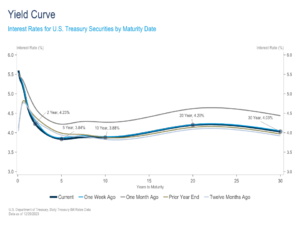Weekly Market Insights 01.02.24
An Amazing Year and a Brave New World
Financial Markets
Both the economy and financial markets showed utter disregard for forecasters’ initial 2023 predictions and had very good years. Of course, the strong equity performance was driven by a very narrow part of the market, but, still, it was a very good year, indeed. The Dow Jones Industrials gained 0.81% for the week and 13.70% for the year. The S&P 500 gained 0.32% for the week and 26.29% for the year. The tech-heavy NASDAQ gained 0.12% for the week and a whopping 44.64% for the year. If any further indication of 2023’s lopsided returns is needed, 74% percent of S&P 500 stocks underperformed the cap-weighted index last year. A remarkable year indeed. As investors and analysts look carefully and compare market returns, they will see how disparate they actually were. Most of the eye popping returns were relegated to just a few names. If asked on the first of the year, many investment managers would have been satisfied to leave 2023 with even just small gains. The most interesting thing about the markets is what they had to overcome politically, economically, and globally, which we will delve into next.
Economics
The year 2023 started while the Russia-Ukraine war was in full force, and by the end, the Israel-Hamas war had erupted. The world was faced with two serious wars with the potential for bad economic consequences. Inflation began the year stubbornly high. Most analysts and portfolio managers doubted Jay Powell and the Federal Reserve had the wherewithal to bring inflation under control without causing a hard landing. With the debt ceiling debacle, threats of government shutdowns, and the Speaker of the House standoff, the political situation in the United States was a complete mess. As we have often written, markets reflect the fears, hopes, and concerns of the societies in which they exist. Clearly, 2023 began on difficult footing, yet the market, driven by a small handful of stocks, had one of its best years on record. Almost none of the above was resolved in 2023. The two wars and political problems at home even escalated. Most of all, commentators got it very wrong when it came to the Fed. The Federal Reserve and its chairman, Jay Powell, appear to have gotten it right. Inflation is coming down, and employment is softening, but not enough to cause a recession yet. Overall, the U.S. economy appears steady, and financial markets have had a Pollyanna ending to what many thought would be a very difficult year.
The past is important and helpful, but investors are interested in the future, which, of course, no one knows. Since it is the start of a new year, we can’t resist sharing our views on 2024 and beyond. None are sure bets, but all are possible. Here are some thoughts:
The U.S. expands its economic dominance relative to the rest of the world, and the dollar remains the dominant global currency. China’s growth does not return to its former strength and winds up in a bitter competition with India. The U.S. economy is clearly leading the global recovery, but some question whether it will continue to be the dominant economy going forward. There are a number of reasons why the answer is yes and that its dominance may actually increase. Some are related to the U.S. economic structure while others have to do with what is occurring around the globe. The U.S. and the rest of the developed world are facing interesting challenges, which have the opportunity to spur non-inflationary growth. What we are referring to may be called the Third Industrial Revolution, spurred at least in part by artificial intelligence. This revolution might show up first in industrial companies adopting new and existing technologies, substituting capital for labor, driving down costs, and making domestic production more profitable. These changes will have important implications for the labor force and the skillsets demanded by employers. The educational system will have to adjust to accommodate the need for a highly skilled workforce. It may also have implications for U.S. immigration policy. Another reason for long-term optimism is there has been an increase in business dynamism. An ongoing study led by John Haltiwanger, Professor of Economics at the University of Maryland, supports this thought. He shows that in the two decades prior to the pandemic, there was a marked slowdown in business creation. The study indicates that during the pandemic, dynamics such as new business applications and new job creation rapidly increased. This dynamic could help to explain the surprising strength of the U.S. labor market. Together, these factors help make a case for steady economic growth.[1]
Next week, we will spend time discussing China’s slowdown and India’s ascent, along with some thoughts on the rest of Asia.
Conclusion
As we wrote at the beginning, most forecasters were incorrect with their initial 2023 predictions. Even so, we could not resist making some forecasts of our own. They are meant to be interpreted simply as possibilities, rather than rock solid forecasts. Our remarks focus on the growth prospects of the United States economy. While many obstacles still stand in the way, there are certainly some positive signs. Without a doubt, the outlook for inflation on January 1st, 2024 looks a lot better than it did on January 1st, 2023.
A VERY HAPPY NEW YEAR TO ALL!

Read pdf here.
[1] For a more detailed discussion, see Brookings paper, “Surging Business Formation in the Pandemic: Causes and Consequences?” September, 2023